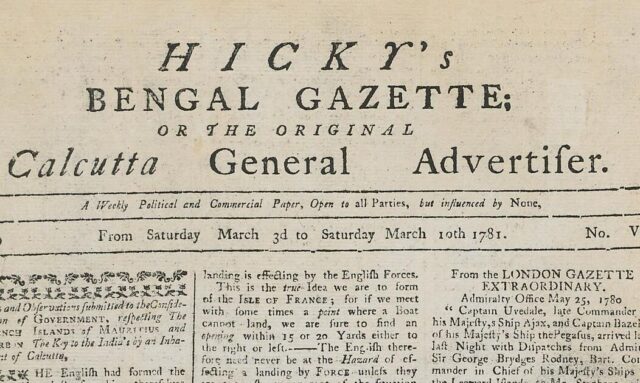Back in Time is ED’s newspaper-like column that reports the past as though it had happened just yesterday. It allows the reader to relive it several years later, on the date it occurred.
January 29, 1780, West Bengal: The first printed newspaper of India, “Hicky’s Bengal Gazette” was originally published today in Calcutta which was the heart of India during British rule. Also known as “Original Calcutta General Advertiser,” it was first issued by an unconventional Irishman called James Augustus Hicky.
The word “gazette” originates from the Italian word “Gazzetta” which was a term for the Venetian newspapers of the 17th century that were sold for one Gazeta, meaning one penny in Venice. Some are also of the opinion that “gazette” is derived from “Gazza,” a word for talkative magpies that were used to deliver news and letters.

Present day, the Gazette of India is a government publication that prints administration notices, international treaties, land acquisition notices, senior officials’ postings, and policy statements.
Hicky’s Bengal Gazette is not only the first printed matter of India, but it is also the first newspaper of Asia. Augustus Hicky as the chief writer, editor and publisher of The Bengal Gazette, worked very hard on his paper. “He tried to cover everything that might be important to Calcutta, devoting many sections to politics, world news and events in India.”
In the initial stages, the journal imparted neutral points of view on the state and administration of Calcutta. With time, Hicky started mocking and criticizing the East India Company and its inefficiency. He blamed the Company for bringing corruption into the country and severely scorned the Governor-General of India, Warren Hastings and his wife, Mary Hastings.
Hicky targeted the upper echelon of colonial India and wrote about their oppression, maladministration, and incompetence. He pointed out how army officers in the subaltern posts received extremely low stipends and how soldiers’ lives were needlessly risked by the Company.
Also Read: I’m Deaf And Dumb. My House Was Burnt. I Have A Gazetted Certificate For It – Will You Give Me Money?
The British officials were particularly angry with Hicky and his newspaper, so they sued his weekly journal for libel and put him in jail. But the fearless person that he was, Hickey continued to publish his journal from his prison cell.
He continued to write about the corruption in the East India Company and how it was harming innocent Indian civilians.
To overshadow Hicky’s Bengal Gazette, Warren Hastings funded a new rival weekly called the “India Gazette.” There wasn’t any opinion section in the paper and the India Gazette soon became East India Company’s official journal publishing government notifications.
Although Hicky desperately fought for the life of the Bengal Gazette, it eventually ceased publication after two years on 23rd March. He could not stand up to the rival power as more and more lawsuits were being filed against him. His newspaper gradually ran out of business.
Post Scriptum
Hicky’s Bengal Gazette managed to inspire later Indian reformers to publish their own newspapers where they portrayed their nationalistic and anti-colonial feelings more critically. Other newspapers that followed Hicky’s Bengal Gazette in the 18th century were the Bengal Journal, Bombay Herald, Oriental Magazine of Calcutta, Calcutta Gazette, and many more.
The Bombay Samachar, first issued in 1822, is now published in Gujarati and English languages. It is the oldest newspaper in Asia that is still in print as the Mumbai Samachar. The Bombay Times, first published in 1838, is now in the market as The Times of India.
India runs the second-greatest newspaper business in the world today. Newspapers have played a significant role in shaping the structure of post-colonial India through new information about the world on a daily basis and by paying respect to varied public opinion.
The Indian Government finally resolved to discard the physical copies of Gazettes in 2015 and introduce a digital version of them. Now the people of India can download and access Gazette notifications without having to pay even a penny.
Image Credits: Google Images
Feature image designed by Saudamini Seth
Sources: The Print & The Hindu
Find the blogger: @ekparna_p
This post is tagged under: history, Back in Time, gazette, first Gazette of India, James Augustus Hicky, Hicky’s Bengal Gazette, India Gazette, gazetta, gazeta, India, Calcutta, Kolkata, colonial period, Independence, British rule, Britishers, colonial India, newspaper, Governor General of India, Warren Hastings, British authorities, The Times of India, The Bombay Times, Bombay Samachar, Mumbai Samachar
Disclaimer: We do not hold any right, copyright over any of the images used, these have been taken from Google. In case of credits or removal, the owner may kindly mail us.
Am interested